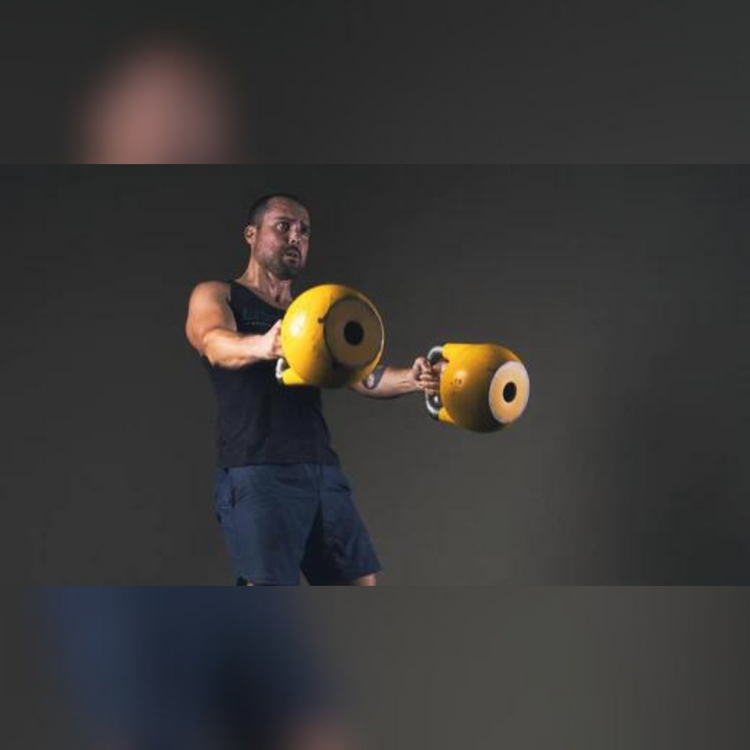5 Kettlebell Do's and Don'ts for Maximum Results

Kettlebells are still the new kid on the block in most big gyms. There are plenty of ellipticals and benches, dumbbells and mirrors, but still only a handful (a small rack if you’re lucky) of kettlebells. Even with ALL the information out there I’ll still see and hear some things being done with these versatile little cannonballs that make me shudder.
What attracts most people to the kettlebell is its devious simplicity and how it can deliver incredible workouts in limited time just about anywhere. From complexes to flows and everything in between you can hit just about every muscle and movement pattern while adding a unique flavor to your sessions.
Here are a few things to avoid as you begin (or continue) your kettlebell journey and some ways to get the most from your training.
#1: Don’t figure it out on your own
The kettlebell is simple in nature and design, but delivers complex exercises. Cleans and snatches may look simple in pictures or on videos, but there’s a lot of moving parts. There’s a delicate balance of tension and fluidity, explosion and control. From hip drive to spinal position to your breath to the amount of output you need all while maneuvering the bell from the ground to overhead and safely back. Don’t be afraid to realize you might not know everything. Find a coach that will help you with the nuances of the exercises and perfect the technique. You’ll gain so much more in much less time (and with far less pain).
#2: Don’t limit yourself to a few movements
There’s so much versatility with these little iron monsters. From traditional exercises like presses and rows to explosive movements like snatches and rotational cleans you can really do a lot with kettlebells. There are some movements that might deliver a little more bang for your buck, but to limit yourself to only a couple of movements because “that’s all you need” is like only eating a couple of types of food because that’s all the nutrients you need. At some point (sooner than later) you’ll get bored at best or develop an overuse injury at worst. Broaden your horizons and add more tools to your toolbox.
#3: Don’t Overdo it
When I first picked up a kettlebell I loved it. I wanted to swing it and row it and clean it and do everything I possibly could. This created issues when I started doing too much too soon. I wanted to run before I could walk. It’s easy to get caught up in what you can do and forget about what you should do or what your body needs. Training too hard too soon will just burn you out and take away from the progress you’re striving for.
#4: Don’t Create an unbalanced workout
The kettlebell is not exempt from the principles of programming. Many programs I see (and have done from weeks on end) neglect certain movement patterns and overwork others. Due to the unique anatomy of the kettlebell you’ll find plenty of vertical pressing and ballistic hinging, but far less horizontal pressing as an example. I’ll see a program with PLENTY of swings without much variety. Make sure you have all movement patterns represented in your plan to avoid creating an imbalance.
#5: Don’t be an elitist
I’ll have to admit I was once this person. The person that thought they knew everything and knew the RIGHT way to do it. I’ve got a newsflash for you. There's more than one way to do a lot of things, kettlebells included. From kettlebell sport to flow to hardstyle and everything in between. There's a WIDE spectrum of training and having a narrow scope will only limit the people you can reach and what you can do in your own training.
So what should I do, Marcus? You’re only telling me what NOT to do! Well, here ya go.
#1: Do learn from multiple sources
Like I just said, there’s a wide range of what you can do with the kettlebell and every coach has their own preferences they gravitate towards, myself included. It’s important to learn from a wide range of coaches to find a system that works for you and then add to that system with your own experience and flair. This will make you a more desirable, well-rounded coach and also give you so much more to experience in your training.
#2: Do work from a plan
It’s easy to get caught up in all the movements and flows you can do with the kettlebell, but it’s important to be working from an overall plan. Map out what you want to accomplish, what you have access to, how much time and energy you’re willing to commit to it, and train accordingly. Random workouts yield random results and even the simplest (albeit balanced) program done consistently will yield FAR greater results than the sporadic all out session.
#3: Do ballistic exercises
What makes the kettlebell unique to other tools can be found in its ability to deliver high powered, ballistic movements very efficiently and effectively. The center of mass and handle allow it to be rotated, flipped, pulled and pushed explosively with greater ease than a dumbbell (once the technique is there). If you’re just doing what most people do with a kettlebell like row, squat, deadlift and farmer carry it you’re missing out on some powerful gains! Make sure to learn the techniques of the swings, cleans, jerks and snatches (and all their variations) to get the most from the kettlebell.
#4: Do try flow at least a few times
In all the years I’ve been teaching kettlebell flow there’s always one or two hardened kettlebellers that are adverse to the whole thing. Those people eventually find some pattern that interests them and then ignites experimentation and some really cool movement combinations that wouldn’t have happened otherwise. Flow is not necessarily for everyday use and is most definitely not the pinnacle of kettlebell training.
It is a powerful way to explore movement patterns, create strength from multiple patterns and positions, increase work capacity, build grip strength, build connection through your entire body, build stronger shoulders, and more. It’s fun IF you let go to the process. If you have to control every aspect of your workout at all times it can be tough to attain flow, but once you start it becomes addictive.
I recommend once you’ve reached a certain level of technique mastery to try a few minutes of light flow with a kettlebell. Where there’s no patterns or sets and just uninhibited movement with the kettlebell. I use flow as conditioning a few times a month and as a challenge with heavier kettlebells to get stronger in places I’m typically weak or areas that I don’t train in a traditionally designed plan.
#5: Do less to gain more
While I just recommended you to learn a lot of movements and try flow at the end of the day it’s important to always work from the principle of “less is more.” Trying to fit everything under the sun into your session will only lead to burnout. Be methodical with your variety. Be intentional with your training. Learn to enjoy the process of small improvements and you won’t find the need to try to do it all every time. There’s a time and place for everything, and by working from a plan, having lots to choose from
Kettlebells offer a unique place in your training so don’t be afraid to learn, apply, assess and repeat!
Stay Strong!!
Author
Marcus
Join us on our new Fat loss program keeping these in mind and watch your body transform!
By: Marcus Martinez










